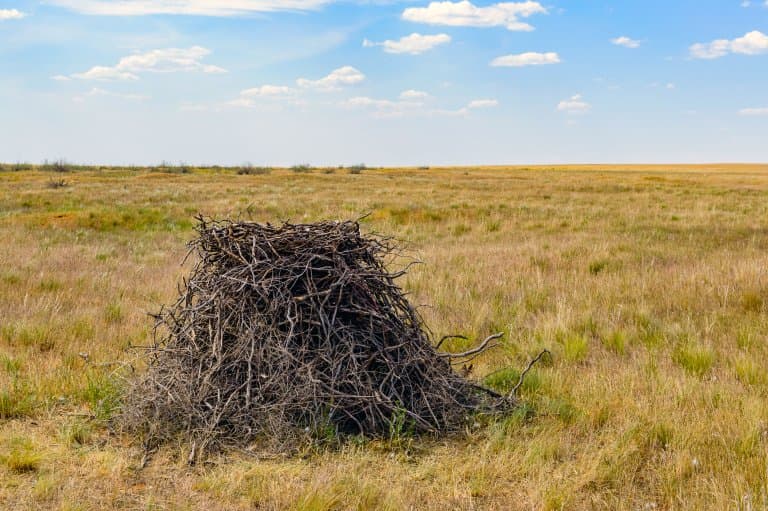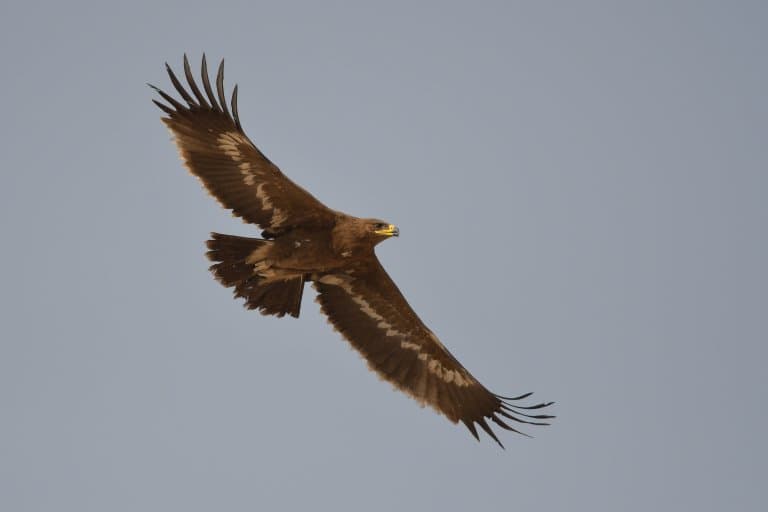Steppe Eagle Profile
It’s easy to take for granted our relative safety from giant airborne predators, but many of our smaller mammalian cousins aren’t so lucky. If you were a ground squirrel, not only would you have to deal with the total lack of acorns, but there’s also a giant bird that has specially evolved to hunt you.
This would be the steppe eagle, and while it might not be the largest threat a ground squirrel has to worry about, it’s certainly the most consistent. The steppe eagle is a large bird of prey, that inhabits the vast open steppes and savannas of Europe and Asia.

Steppe Eagle Facts Overview
| Habitat: | Steppe and semi-desert, up to 2300 meters |
| Location: | Eurasia, Middle East, Africa, Southeast Asia |
| Lifespan: | 40 years |
| Size: | 262 cm (8 ft 7 in) wingspan (maybe) |
| Weight: | Up to 5kg (11 lb) |
| Colour: | Mostly dark brown, grey wing tips |
| Diet: | Opportunistic, mostly ground squirrels |
| Predators: | None |
| Top Speed: | Mean gliding speed of 60 km/h (36 mph) |
| No. of Species: | 1 |
| Conservation Status: | Endangered (IUCN) |
Steppe eagles are in the booted eagle subfamily. They’re extremely good at two things: flying without flapping their wings and destroying ground squirrels.
These two things combine to push the bird on epic migrations during times of squirrel drought, but they’ve had to adapt their behaviour to avoid the destructive effects of human encroachment.
Unfortunately, this hasn’t been quite enough and they are endangered.
Interesting Steppe Eagle Facts
1. They’re booted eagles
Booted eagles are so named because they have awesome ruffs around their ankles. They make up the subfamily Aquilinae, and while they’re quite closely related, they’re also a very diverse group, ranging from the 500g pygmy eagle, all the way up to the 9 kg Martial eagle.
Steppe eagles are right in the mid-range for the subfamily, but there’s nothing mid about them. These are very well-adapted birds.
Steppe eagles can have a wingspan of over 2m (7ft) and were 10th in our largest eagles in the world by wingspan list.

2. They’re efficient flyers
Steppe Eagles have exceptional agility. Around 90% of their flight time is soaring, which is great for conserving energy, and their flight techniques have been the subject of several studies on account of just how subtle and elegant it is.
These eagles are experts at riding thermals, and once they’re up there, switch to long, straight soaring, and using this combined method, they can cover impressive distances. 1 2
3. They nest on the ground
Despite their high altitude adaptations, these birds like to nest on the ground. Steppe eagles nest on the ground more frequently than any other species of eagle, and here, one to three eggs are laid, one or two of which will make it to fledge.
Nest are typically made up to 1m in size using sticks, although researchers in Mongolia once found a nest that wasn’t made from sticks, but rather large mammal bones!
This nesting strategy is related to their preferred food source, but it has recently proven to be a bit of a handicap, as the expansion of livestock rearing in their home ranges has led to a serious case of egg trampling by domestic ungulates.
Fires are also a threat, as they can spread across the ground and destroy nests.

4. They’ve had to adapt
Luckily enough, they’re not opposed to adapting their behaviour as needed. The species has been seen moving to a more raised platform nesting strategy in areas where their ground nests are vulnerable.
Bushes and trees are commonly used, but they’re also known for making their homes on artificial structures, too. Rubbish sites are a particular preference, likely because of the increased food options and the lower rate of human disturbance. 3
5. They’re squirrel specialists
But raised nests aren’t the best for an animal that specialises in ground food. Steppe eagles are more specialised than many species of eagle, and while they will take more or less anything, they greatly prefer ground squirrels.
So much so, that in some populations, the poor rodent makes up 98% of the eagle’s diet. These squirrels represent a dense population of easy-access food for the eagle, which again, is why they like rubbish piles.
Steppe eagles are relatively lazy birds, so the simpler the food, the better. Unfortunately for the eagle (and the squirrel), ground squirrel populations have plummeted in many parts of their range, and so the eagle makes use of other options, like voles, pikas, and gerbils.
6. They’re not good in the cold
This laziness is exemplified in the winter behaviour of the bird. When it’s too cold to hunt, they remain slow-moving and relatably unenthusiastic. They’ll wander around nibbling on insects, scavenging, and generally picking at whatever morsels come their way.
Termite mounds are great for this, and in some populations, mounds will be home to roosts of multiple birds. They’re quite good at this eating style, too, and will get through more than 2,000 termites in just a few hours of feeding.
7. They engage in mass migrations
The drop in temperatures and squirrel availability motivates this bird to find better pastures, and it does so using its incredibly efficient flight.
These birds breed and spends summer at high altitudes, then fly as far as the Middle East and Southern Africa for the summer. Since they avoid water, vast numbers of migrants can be found during migration season, gathered at bottlenecks along the route.
Migrations can take over thousands of kilometres and involve tens of thousands of birds. 4

8. They’re vulnerable to diclofenac
The use of the NSAID medicine diclofenac in livestock has been associated with declines in a huge number of vulture species, but its effects on eagles have been less measured.
Unfortunately, a bird with this incredible range is hard to protect, and the news that diclofenac is also toxic to Steppe Eagles is not a good sign. India and Pakistan are substantial contributors to the diclofenac problem, and with such large populations, changes take a long time to affect.
The rise in livestock farming brings with it a multitude of threats to many species, and diclofenac is proving to be a big one. For birds who cross multiple country borders, conservation then becomes a significant challenge. 5
9. The conversion of the Steppe is wiping them out
As more of the Steppe is being converted to agricultural land, this species is being extirpated from its former range.
Power lines are another problem, particularly in Western Kazakhstan, Russia and Saudi Arabia. Pesticide poisoning is also an issue, as rodent poison works its way up the food chain.
Logging and mining have reduced their habitats further and the aforementioned nest destruction reduces the species’ ability to recover. There’s also an illegal market for eagle chicks in Western Europe that funds the poaching of this species, among others.
As of now, the species is listed as Endangered and decreasing by the IUCN.
10. They are national birds for Kazakhstan and Egypt
The steppe eagle appears on the national flag of Kazakhstan flying under the sun in the middle of the design, and is the national bird of Egypt as well.
Eagles were an important symbol in ancient Egypt and are seen across temples. The steppe eagle was a treasured bird of Egypt’s first Sultan, Saladin, and is so often referred to as the Saladin Eagle.
Steppe Eagle Fact-File Summary
Scientific Classification
| Kingdom: | Animalia |
| Phylum: | Chordata |
| Class: | Aves |
| Order: | Accipitriformes |
| Family: | Accipitridae |
| Genus: | Aquila |
| Species: | Aquila Nipalensis |
Fact Sources & References
- Reto Spaar (1996), “Soaring Migration of Steppe Eagles Aquila nipalensis in Southern Israel: Flight behaviour under Various Wind and Thermal Conditions”, JSTOR.
- James A. (2011), “Soaring and manoeuvring flight of a steppe eagle Aquila nipalensis”, Wiley Online Library.
- “Steppe Eagle”, IUCN Red List.
- Bernd-U. Meyburg (2003), “Migration Routes of Steppe Eagles between Asia and Africa: A Study by Means of Satellite Telemetry”, JSTOR.
- ANIL K. SHARMA (2014), “Diclofenac is toxic to the Steppe Eagle Aquila nipalensis: widening the diversity of raptors threatened by NSAID misuse in South Asia”, Cambridge University Press.
